Aircraft Fuel Cells Market by Fuel Type (Hydrogen, Hydrocarbon, Others), Power Output (0-100kW, 100 kW- 1MW, 1MW & Above), Aircraft Type (Fixed-Wing, Rotary Wing, UAVs, AAMs) and Region (North America, Europe, APAC, RoW) - Global Forecast to 2035
The Aircraft Fuel Cell Market size is projected to grow from USD 1.6 Billion in 2023 to USD 5.7 Billion by 2035, at a CAGR of 10.8% from 2023 to 2035. Aircraft fuel cells serve a vital function in the aviation industry by providing efficient and clean power generation for various applications. Fuel cells convert the chemical energy of fuels, like hydrogen or hydrocarbon, into electricity through an electrochemical process. In Aircraft Fuel Cell Industry, these are utilized for propulsion systems, enabling more efficient and environmentally friendly aircraft engines. They also find application as auxiliary power units (APUs), supplying electricity for aircraft systems during ground operations and reducing reliance on traditional engine-based power generation. Additionally, fuel cells are used as backup power sources in emergency situations, ensuring uninterrupted operation of critical systems. By powering essential equipment and systems, such as communication, navigation, and safety devices, fuel cells enhance aircraft safety and reliability.
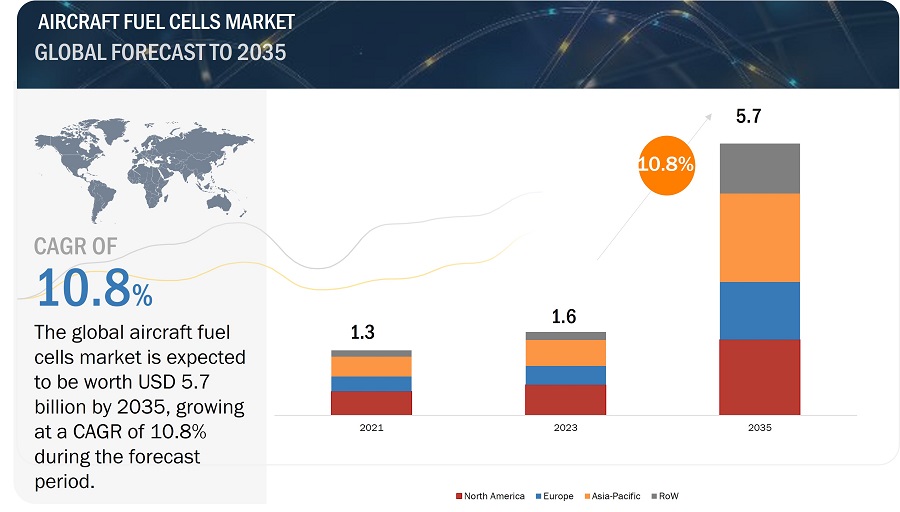
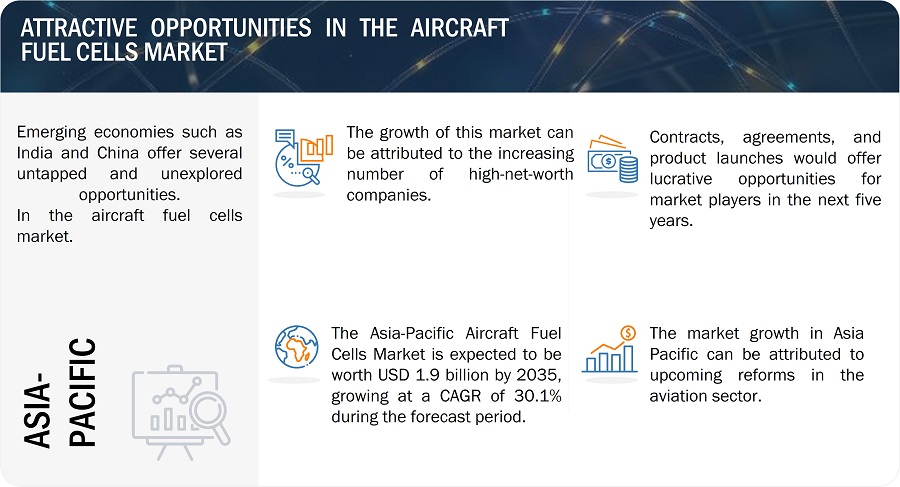
Aircraft Fuel Cells Market Forecast to 2035
To know about the assumptions considered for the study, Request for Free Sample Report
Aircraft Fuel Cell Market Dynamics.
Driver: Fuel Cell Innovation and Cost Efficiency Propel the Growth in the Aircraft Industry
Innovation in fuel cell technology is a catalyst for market growth. Ongoing research and development efforts focus on enhancing fuel cell performance, durability, and efficiency. Innovations in materials, design, and manufacturing processes have led to higher energy conversion rates, improved power output, and extended fuel cell lifespan. Additionally, advancements in system integration and control technologies contribute to the reliability and adaptability of fuel cell systems. Cost efficiency is a critical factor in driving the adoption of fuel cell technology in the aircraft industry. Over the years, significant progress has been made in reducing the cost of fuel cell systems. Innovations in manufacturing processes, economies of scale, and increased market competition have resulted in cost reductions. As fuel cell costs become more competitive with conventional power sources, the business case for adopting fuel cell technology in aircraft becomes stronger. The potential for long-term cost savings in fuel consumption, maintenance, and operational efficiency further drives the market growth. These factors are expected to drive the fuel cell market in the future.
Restraint: Hydrogen storage and cooling
One of the primary challenges in fuel cell technology is the storage of hydrogen, the fuel used in fuel cells. Hydrogen has a low energy density and requires large storage tanks or complex systems for compression or liquefaction. These storage solutions can add weight and volume to the aircraft, impacting fuel efficiency and payload capacity. Moreover, ensuring the safe handling and storage of hydrogen is crucial due to its flammability. These factors pose technical and logistical challenges that need to be overcome to enable efficient and practical hydrogen storage for aircraft fuel cells. Fuel cells generate heat during operation, requiring effective cooling systems to maintain optimal performance and prevent overheating. Cooling systems in aircraft fuel cells must be efficient, lightweight, and capable of handling high heat loads. Designing and integrating effective cooling systems can be complex and expensive, impacting the overall cost and complexity of the fuel cell system. Failure to properly manage heat dissipation can lead to reduced fuel cell efficiency and potential damage to the system, necessitating careful design considerations and advanced thermal management solutions. These factors act as a restraint to the market growth.
Opportunity: Innovation in HPTEM technology to increase the adoption of aircraft fuel cells
Innovation in HPTEM technology brings the prospect of enhanced fuel cell performance. HPTEMs have the potential to exhibit higher proton conductivity, allowing for more efficient ion transport within the fuel cell. This, in turn, can lead to improved power output, energy conversion efficiency, and overall system performance. The ability of HPTEMs to operate under a wide range of temperatures also makes them adaptable to different aircraft operating conditions, enhancing their reliability and effectiveness. HPTEM technology offers the opportunity to enhance the durability of fuel cell systems. Innovations in HPTEM materials and manufacturing processes can lead to increased resistance to degradation from factors such as high temperatures, fuel impurities, and system cycling. By improving the durability of fuel cells, HPTEM technology can contribute to longer lifespan, reduced maintenance requirements, and increased overall reliability of fuel cell systems in aircraft applications. Innovations in HPTEM technology have the potential to improve cost-effectiveness in the aircraft fuel cell market. HPTEM materials can be manufactured using cost-efficient methods, such as roll-to-roll processing, allowing for large-scale production at lower costs. Moreover, the enhanced durability of HPTEMs can reduce the need for frequent replacements or repairs, leading to cost savings in terms of maintenance and system downtime. These cost advantages make HPTEM-based fuel cell systems more economically viable, creating opportunities for wider adoption in the aviation industry.
Challenge: Enhancing heat removal capabilities of LPTEM fuel cells
Ensuring effective heat removal for the integration of Low-Platinum Thin-Film Electrolyte Membrane (LPTEM) fuel cells presents a significant challenge for the aircraft fuel cell industry. LPTEM fuel cells generate heat during operation, necessitating efficient thermal management to maintain optimal performance and prevent overheating. The compact design requirements of aircraft impose limitations on the available space for integrating cooling systems. Thus, lightweight and efficient cooling mechanisms must be developed to dissipate heat without compromising other critical components or adding excessive weight. Moreover, the integration of heat removal systems must be carefully engineered to minimize aerodynamic impacts and maintain optimal aircraft performance. Overcoming these challenges calls for ongoing research and development efforts to design and implement advanced cooling systems that strike a balance between space constraints, weight considerations, aerodynamic requirements, and efficient heat dissipation. By addressing these challenges, the aircraft fuel cell industry can optimize LPTEM fuel cell integration, ensuring reliable operation, enhanced performance, and extended longevity in aircraft applications.
Aircraft Fuel Cell Market Ecosystem
Several significant companies that specialize in designing and manufacturing high-quality fuel cells for the aerospace industry serve the aircraft fuel cell market. These organisations have established themselves as leaders due to their wide product portfolios, technological expertise, and strong client ties. They cater to a wide range of aircraft applications, providing fuel cells that fulfill strict industry standards for performance, dependability, and safety. Furthermore, these companies are always investing in research and development to create innovative sealing systems that answer the changing needs of the aviation sector. The prominent companies are ZeroAvia Inc. (US), Intelligent Energy Limited (UK), Piasecki Aircraft Corporation (US), Doosan Mobility Innovation (South Korea), and H3 Dynamics (Singapore), among others.
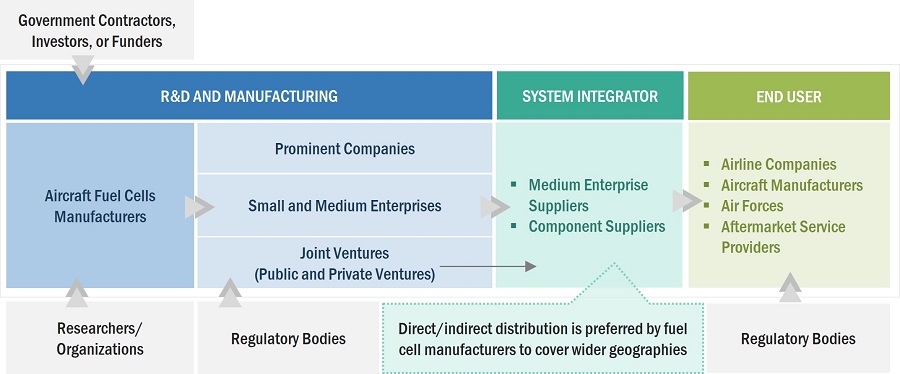
The UAV segment accounts for the largest market size during the forecast period.
Based on Aircraft Type, the market has been segmented into fixed-wing, rotary-wing, UAVs, and AAM in the aircraft fuel cell market.
The UAV (Unmanned Aerial Vehicle) segment holds the highest market share in the aircraft fuel cell market for several key reasons. Firstly, UAVs are increasingly being adopted for various applications, including surveillance, remote sensing, delivery services, and more. These unmanned aircraft require efficient and lightweight power solutions, making fuel cells an attractive choice due to their high energy density and longer flight durations compared to traditional batteries. Secondly, fuel cells offer advantages such as quiet operation, reduced vibration, and low heat signature, which are highly beneficial for UAV applications. These characteristics enable UAVs to operate stealthily and with minimal detection, making them ideal for military, surveillance, and security purposes. Additionally, UAVs often require long endurance and extended flight range, which can be achieved with fuel cells. Fuel cells provide a continuous and reliable source of power, enabling UAVs to stay airborne for extended periods, covering larger distances without the need for frequent refueling or recharging.
The 0-100 kW segment is projected to have a greater market share during the forecast period.
Based on the Power Output, the aircraft fuel cell market has been segmented into 0-100 kW, 100 kW- 1MW, 1 MW & above. The 0-100 kW segment holds a significant market share due to its compatibility with emerging trends in electric aviation, such as electric vertical take-off and landing (eVTOL) aircraft. These aircraft, often used for urban air mobility and air taxis, rely on compact and efficient power systems within the 0-100 kW power range. Additionally, advancements in fuel cell technology have made the 0-100 kW segment more attractive. These advancements have led to improved energy conversion efficiency, enhanced durability, and reduced costs, making fuel cells within this power range more viable and competitive compared to other power sources. The increasing adoption of smaller aircraft and UAVs in various industries is driving the demand for fuel cells within this power range. These aircraft often require compact and lightweight power solutions to meet their specific requirements. The 0-100 kW segment addresses these needs effectively, offering efficient and reliable power generation for smaller aircraft.
Asia Pacific is projected to grow at the highest CAGR during the forecast period.
Asia Pacific is projected to be the fastest-growing region in the aircraft fuel cell market during the forecast period, owing to a number of variables that support the region's growth potential. The region has witnessed significant economic development, which has resulted in greater air travel demand and a rising commercial aviation sector. The rising emphasis on sustainable aviation practices and the emergence of urban air mobility and advanced air mobility solutions will drive the demand for aircraft fuel cells. Numerous growing economies, like China and India, have made significant investments in their aerospace sectors in Asia Pacific. The presence of important aircraft manufacturers and suppliers in the region has contributed to Asia-Pacific's market leadership in aircraft fuel cells.
Asia Pacific is projected to hold the highest market share during the forecast period.
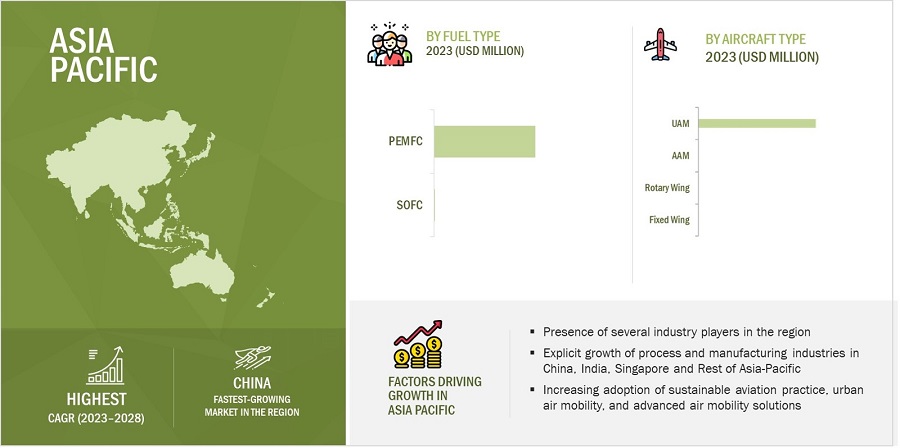
Aircraft Fuel Cells Market by Region
To know about the assumptions considered for the study, download the pdf brochure
Aircraft Fuel Cells Industry Companies: Top Key Market Players
Get online access to the report on the World's First Market Intelligence Cloud
- Easy to Download Historical Data & Forecast Numbers
- Company Analysis Dashboard for high growth potential opportunities
- Research Analyst Access for customization & queries
- Competitor Analysis with Interactive dashboard
- Latest News, Updates & Trend analysis
Request Sample Scope of the Report
Get online access to the report on the World's First Market Intelligence Cloud
- Easy to Download Historical Data & Forecast Numbers
- Company Analysis Dashboard for high growth potential opportunities
- Research Analyst Access for customization & queries
- Competitor Analysis with Interactive dashboard
- Latest News, Updates & Trend analysis
|
Report Metric |
Details |
|
Estimated Market Size
|
USD 1.6 Billion in 2023
|
|
Projected Market Size
|
USD 5.7 Billion by 2035
|
|
Growth Rate
|
CAGR of 10.8%
|
|
Market size available for years |
2019-2035 |
|
Base year considered |
2023 |
|
Forecast period |
2024-2035 |
|
Forecast units |
Value (USD Million/Billion) |
|
Segments Covered |
By Fuel Type, Power Output, Aircraft Type, and Region |
|
Geographies Covered |
North America, Europe, Asia-Pacific, and Rest of the World |
|
Companies Covered |
ZeroAvia Inc. (US), Intelligent Energy Limited (UK), Piasecki Aircraft Corporation (US), Doosan Mobility Innovation (South Korea), and H3 Dynamics (Singapore), among others. |
Aircraft Fuel Cells Market Highlights
This research report categorizes the Aircraft Fuel cells market based on Fuel Type, Power Output, Aircraft Type, and Region.
|
Segment |
Subsegment |
|
By Fuel Type |
|
|
By Power Output |
|
|
By Aircraft Type |
|
Recent Developments
- Airbus, the renowned French aviation company, has recently unveiled its plans to develop a hydrogen-powered fuel cell engine and conduct testing on an unprecedented scale. The engine will be installed in a modified A380 superjumbo, positioned between the wings and tail of the aircraft. This significant milestone is part of Airbus' ambitious ZEROe initiative, aimed at introducing a zero-emission aircraft by 2035. Test flights for this hydrogen-powered engine are anticipated to commence in 2026.
- PowerCell, a leading fuel cell technology company, has achieved a groundbreaking milestone by signing a historic contract with ZeroAvia, a pioneering zero-emission aviation company. This contract marks the world's first-ever agreement for the serial delivery of hydrogen fuel stacks to the aviation industry. The agreement, valued at up to SEK 1.51 billion, is contingent on ZeroAvia obtaining the necessary certifications and entails the supply of 5,000 hydrogen fuel cell stacks. The deliveries are scheduled to commence in 2024. ZeroAvia, known for its focus on hydrogen-electric aviation solutions, aims to launch a 19-seat aircraft with a range of 300 miles by 2025.
- ZeroAvia, a pioneering company specializing in zero-emission solutions for commercial aviation, has achieved a significant milestone in its pursuit of delivering hydrogen-electric engines for regional jets through an expanded agreement with MHI RJ Aviation Group (MHIRJ). The collaboration entails MHIRJ providing valuable engineering services and aircraft integration expertise and leveraging its renowned OEM experience to facilitate the certification of ZeroAvia's hydrogen-electric powertrain for retrofitting onto airframes in the regional jet markets.
Frequently Asked Questions (FAQ):
What is the current size of the aircraft fuel cell market?
The aircraft fuel cell market size is projected to grow from USD 1.6 Billion in 2023 to USD 5.4 Billion by 2035, at a CAGR of 10.3% from 2023 to 2035.
Who are the winners in the aircraft fuel cell market?
ZeroAvia Inc. (US), Intelligent Energy Limited (UK), Piasecki Aircraft Corporation (US), Doosan Mobility Innovation (South Korea), and H3 Dynamics (Singapore), among others. Are some of the winners in the market.
What are some of the technological advancements in the aircraft fuel cell market?
The aircraft fuel cell market has experienced significant technological advancements, driving its growth and development. These advancements include the development of high-temperature fuel cells like Solid Oxide Fuel Cells (SOFCs), which offer greater efficiency and power output. Lightweight and compact designs have been achieved through material and manufacturing innovations, making fuel cells more suitable for aircraft integration. Improvements in durability and longevity have resulted in enhanced performance and reduced maintenance requirements. Advancements in hydrogen infrastructure and storage technologies ensure a reliable supply of hydrogen fuel. The emergence of hybrid systems, combining fuel cells with other power sources, provides flexibility and improved performance.
What are the factors driving the growth of the aircraft fuel cell market?
The increasing emphasis on sustainable aviation practices, fuel cell innovation, and cost efficiency of operation, along with rising prices of conventional fuels and technological advancements in material and manufacturing technologies, are some of the factors driving the growth of the aircraft fuel cell market.
What are the growth opportunities in the aircraft fuel cell market?
The aircraft fuel cell market offers several prospects for expansion to players. Market expansion is being driven by innovation in fuel cell technologies, and the advent of new aircraft programs and systems to power the future of smaller aircraft and electric flight.
To speak to our analyst for a discussion on the above findings, click Speak to Analyst
The study involved four major activities in estimating the current market size for the Aircraft fuel cells market. Exhaustive secondary research was conducted to collect information on the market, the peer markets, and the parent market. The next step was to validate these findings, assumptions, and sizing with industry experts across the value chain through primary research. Both top-down and bottom-up approaches were employed to estimate the complete market size. Thereafter, market breakdown and data triangulation procedures were used to estimate the market size of segments and subsegments.
Secondary Research
In the secondary research process, various secondary sources, such as D&B Hoovers, Bloomberg, BusinessWeek, Dow Jones Factiva, and different magazines, were referred to identify and collect information for this study. Secondary sources also included annual reports, press releases & investor presentations of companies, certified publications, articles by recognized authors, and simulator databases. Secondary sources referred for this research study included General Aviation Manufacturers Association (GAMA); International Air Transport Association (IATA) publications, corporate filings (such as annual reports, investor presentations, and financial statements); Federal Aviation Administration (FAA) and trade, business, and professional associations. Secondary data was collected and analyzed to arrive at the overall market size, which was further validated by primary respondents.
Primary Research
The Aircraft fuel cells market comprises several stakeholders, such as raw material providers, Aircraft fuel cell manufacturers and suppliers, and regulatory organizations in the supply chain. While the demand side of this market is characterized by various end users, the supply side is characterized by technological advancements in materials and types. Various primary sources from both the supply and demand sides of the market were interviewed to obtain qualitative and quantitative information. Following is the breakdown of primary respondents:
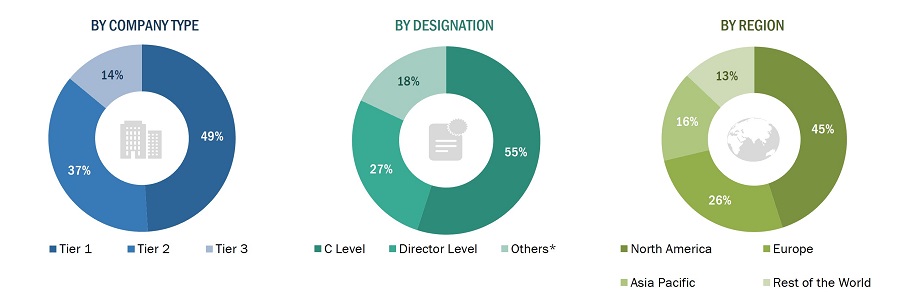
To know about the assumptions considered for the study, download the pdf brochure
Market Size Estimation
The top-down and bottom-up approaches were used to estimate and validate the size of the aircraft fuel cells market. The research methodology used to estimate the size of the market includes the following details.
The key players in the aircraft fuel cells market were identified through secondary research, and their market shares were determined through primary and secondary research. This included a study of the annual and financial reports of the top market players and extensive interviews with leaders such as directors, engineers, marketing executives, and other stakeholders of leading companies operating in the aircraft fuel cells market.
All percentage shares, splits, and breakdowns were determined using secondary sources and verified through primary sources. All possible parameters that affect the markets covered in this research study were accounted for, viewed in extensive detail, verified through primary research, and analyzed to obtain the final quantitative and qualitative data on the aircraft fuel cells market. This data was consolidated, enhanced with detailed inputs, analyzed by MarketsandMarkets, and presented in this report.
Bottom-Up Approach
The bottom-up approach was employed to arrive at the overall size of the aircraft fuel cells market. The market size estimation method is delineated below:
The study focuses on two types of aircraft deliveries: (1) aircraft that will be running completely on hydrogen fuel cells, with adoption expected in later years, and (2) aircraft utilizing fuel cells for applications such as auxiliary power units (APUs) and emergency power.
a. Hydrogen Fuel Cell Aircraft:
Collect data on projected deliveries of aircraft that will run completely on hydrogen fuel cells for future years.
Estimate the market size based on the number of hydrogen fuel cell-powered aircraft expected to be delivered each year.
Calculate the potential market value by considering the average price of hydrogen fuel cell systems for aircraft and estimated demand.
b. Fuel Cell Applications in Existing Aircraft:
Gather data on the number of existing aircraft utilizing fuel cells for applications such as APUs and emergency power.
Estimate the market size by considering the number of aircraft equipped with fuel cell systems for these applications.
Determine the market value by analyzing the average price of fuel cell systems for APUs and emergency power.
- Aircraft Fuel cells Market = Aircraft Type 1 + Aircraft Type 2
Aircraft fuel cells market for Aircraft Type 1
|
Step 1 |
Mapping deliveries of all types of aircraft |
Mapped the operating fleet size of all types of aircraft from 2019 to 2035 based on historical data and projects announced by OEMs during the forecast period |
|
Step 2 |
Identifying the rate of adoption of aircraft fuel cells in each type of aircraft |
The rate of adoption of each aircraft model type by aircraft manufacturers was identified; the penetration of aircraft fuel cells cost is varied |
|
Step 3 |
Identifying the cost of aircraft fuel cells solutions |
Identified the cost of aircraft fuel cells solutions in various types of aircraft |
|
Step 4 |
Arriving at the OEM aircraft fuel cells market size |
Aircraft Fuel cells OEM Market = Sum [(Aircraft Type 1 Deliveries * Rate of Adoption * Cost of aircraft fuel cell), (Aircraft Type 2 deliveries * Rate of Adoption * Cost of FUEL CELL), (Aircraft Type 3 deliveries * Rate of Adoption * Cost of FUEL CELL), ……(Aircraft Type Deliveries * Rate of Adoption * Cost of FUEL CELL)] |
Aircraft fuel cells market for Aircraft Type 2
|
Step 1 |
Mapping the fleet of aircraft |
Mapped deliveries of all types of aircraft from 2019 to 2023 and projections for years till 2035 |
|
Step 2 |
Mapping retrofit contracts |
Contracts associated with retrofitting across regions were mapped from 2018 to identify trends |
|
Step 3 |
Identifying the rate of adoption |
The adoption of aircraft fuel cells across platforms was identified by mapping the historical data; the rate of adoption at the regional level was arrived at. |
|
Step 4 |
Cost of Aircraft fuel cell and application |
ASP of aircraft fuel cells was identified for various platforms. |
|
Step 5 |
Arriving at the aftermarket size |
Aircraft Fuel cells Aftermarket = (Operating Aircraft * Application Type * Aircraft Fuel Cell Cost for Platform) |
In the bottom-up approach, the size of the aircraft fuel cells market was arrived at by calculating the country-level data. In the top-down approach, the market size was derived by estimating the revenues of key companies operating in the market and validating the data acquired from primary research.
Market size estimation methodology: Bottom-up Approach
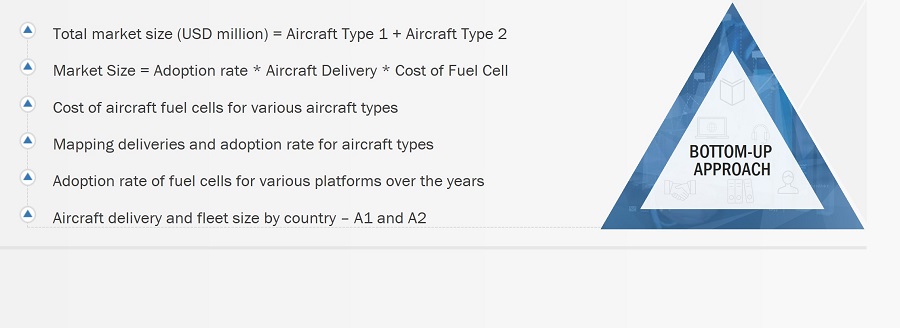
Top-Down Approach
In the top-down approach, aircraft fuel cell solution providers were identified. Their revenue specific to the aircraft fuel cells market was identified. The base market number for each player was arrived at by assigning weightage to aircraft fuel cell contracts.
Market Size Estimation Methodology: Top-Down Approach

Data Triangulation
After arriving at the overall size of the aircraft fuel cells market from the estimation process explained above, the total market was split into several segments and subsegments. The data triangulation and market breakdown procedures explained below were implemented, wherever applicable, to complete the overall market engineering process and arrive at the exact statistics for various market segments and subsegments. The data was triangulated by studying various factors and trends from the demand and supply sides. Along with this, the market size was validated using the top-down and bottom-up approaches.
Market Definition & Key Stakeholders
The aircraft fuel cells market encompasses the development, manufacturing, and implementation of specialized fuel cell systems designed for aircraft applications. These fuel cells, utilizing hydrogen or hydrogen-rich fuels, provide cleaner and more efficient power generation compared to traditional combustion engines. Key stakeholders in this market include aircraft manufacturers, fuel cell technology providers, airlines, research institutions, and regulatory authorities. Collaboratively, they drive innovation, ensure safety standards, and facilitate the integration of sustainable power generation into aircraft propulsion and auxiliary systems. The aircraft fuel cells market represents a transformative opportunity to reduce carbon emissions, enhance the energy efficiency, and promote the overall sustainability of the aviation industry.
Key Stakeholders
- Aircraft Manufacturers
- Fuel Cell Technology providers
- Airlines
Report Objectives
- To identify and analyze key drivers, restraints, challenges, and opportunities influencing the growth of the Aircraft fuel cells market
- To analyze the impact of macro and micro indicators on the market
- To forecast the market size of segments for four regions, namely, North America, Europe, Asia Pacific, and Rest of the World. Along with major countries in each of these regions
- To strategically analyze micro markets with respect to individual technological trends, prospects, and their contribution to the overall market
- To strategically profile key market players and comprehensively analyze their market ranking and core competencies
- To provide a detailed competitive landscape of the market, along with an analysis of business and corporate strategies, such as contracts, agreements, partnerships, and expansions.
- To identify detailed financial positions, key products, unique selling points, and key developments of leading companies in the market
Available customizations
Along with the market data, MarketsandMarkets offers customizations as per the specific needs of companies. The following customization options are available for the report:
Product Analysis
- Product matrix, which gives a detailed comparison of the product portfolio of each company
Regional Analysis
- Further breakdown of the market segments at country-level
Company Information
- Detailed analysis and profiling of additional market players (up to 6)












Growth opportunities and latent adjacency in Aircraft Fuel Cells Market